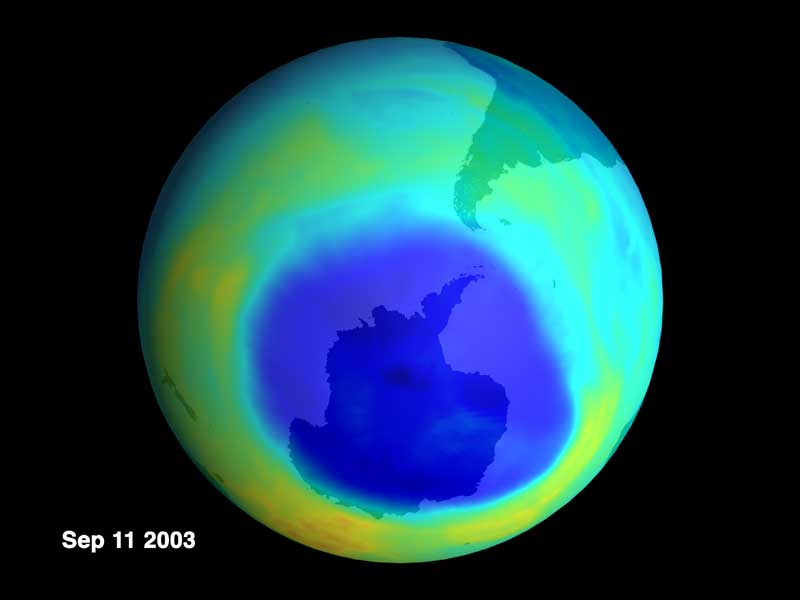
|
||||||||||||||||||||||||
|
2003 Ozone 'Hole' Approaches, But Falls Short of Record
A view of Earth's ozone hole, September 11, 2003 NASA 9.25.03 This year's Antarctic ozone hole is the second largest ever observed, according to scientists from NASA, the National Oceanic and Atmospheric Administration (NOAA), and the Naval Research Laboratory (NRL). The Antarctic ozone "hole" is defined as thinning of the ozone layer over the continent to levels significantly below pre-1979 levels. Ozone blocks harmful ultraviolet "B" rays. Loss of stratospheric ozone has been linked to skin cancer in humans and other adverse biological effects on plants and animals. The size of this year's Antarctic ozone hole reached 10.9 million square miles on September 11, 2003, slightly larger than the North American continent, but smaller than the largest ever recorded, on September 10, 2000, when it covered 11.5 million square miles. Last year the ozone hole was smaller, covering 8.1 million square miles. NASA's Earth Probe Total Ozone Mapping Spectrometer and the NOAA-16 Solar Backscatter Ultraviolet instrument provided ozone measurements from space. These data were coupled with data collected by NOAA?s Climate Monitoring and Diagnostics Laboratory (CMDL) from balloon-borne instruments, which measure the ozone hole?s vertical structure. NASA scientist Paul Newman said, "While chlorine and bromine chemicals cause the ozone hole, extremely cold temperatures, especially near the edge of Antarctica, are also key factors in ozone loss." Given the leveling or slowly declining atmospheric abundance of ozone-destroying gases, the year-to-year changes in the size and depth of the ozone hole are dominated by the year-to-year variations in temperature in this part of the atmosphere. The fact that this year's ozone loss is much greater than last year's reflects the very different meteorological conditions between these two years. NASA scientist Rich McPeters said that ozone observations showed the total amount of ozone from surface to space was 106 Dobson Units (DU) on September 14, 2003, the minimum value reached this year. "Dobson units" measure the "thickness" of protective ozone in the stratosphere. They range from 100 DU to 500 DU, which translate to about 1 millimeter (1/25 inch) to 5 millimeters (1/5 inch) of ozone in a layer. Bryan Johnson of CMDL said the ozone depletion region, from 7-to-14 miles above the Earth, has large losses, similar to losses seen in the 1990s. If the stratospheric temperature remains cold over the pole, then we should see complete ozone loss in the 9-13 mile layer, with total column ozone reaching 100 DU by early October. The Montreal Protocol and its amendments banned chlorine-containing chlorofluorocarbons (CFCs) and bromine-containing halons in 1995, because of their destructive effect on the ozone. However, CFCs and halons are extremely long-lived and still linger at high concentrations in the atmosphere. However, the atmospheric abundances of ozone destroying chemicals are beginning to decline. As a result, the Antarctic ozone hole should disappear in about 50 years. NASA's Earth Science Enterprise is dedicated to understanding the Earth as an integrated system and applying Earth System Science to improve prediction of climate, weather, and natural hazards using the unique vantage point of space. NOAA is dedicated to enhancing economic security and national safety through the prediction and research of weather and climate-related events and providing environmental stewardship of our nation's coastal and marine resources. To learn more about NOAA, please visit: More information, movies and high resolution images see: NASA Goddard Space Flight Center Related Links: NOAA's Climate Monitoring and Diagnostics Laboratory Rob Gutro NASA Goddard Space Flight Center |



